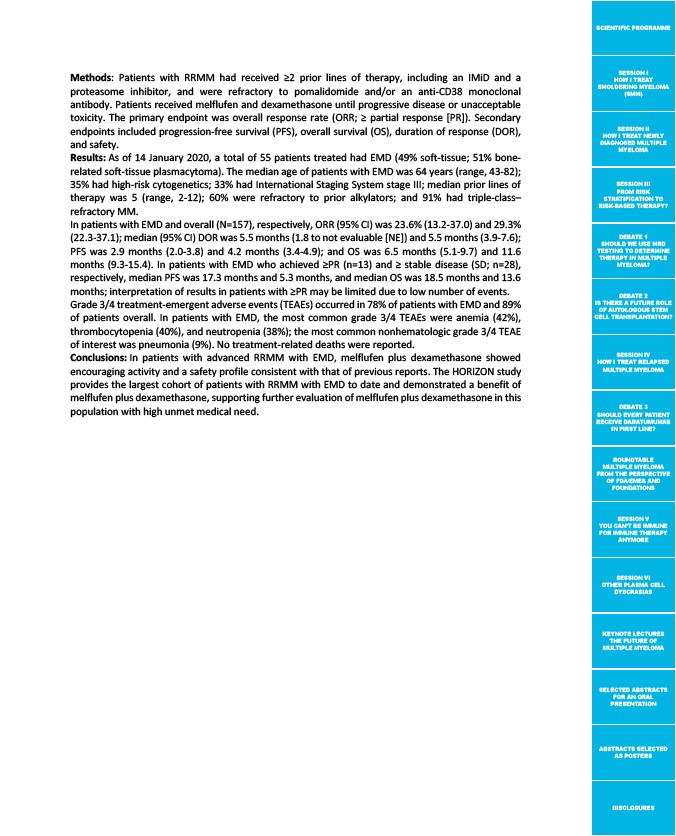
SCIENTIFIC PROGRAMME
SESSION I
HOW I TREAT
SMOLDERING MYELOMA
(SMM)
SESSION II
HOW I TREAT NEWLY
DIAGNOSED MULTIPLE
MYELOMA
SESSION III
FROM RISK
STRATIFICATION TO
RISK-BASED THERAPY?
DEBATE 1
SHOULD WE USE MRD
TESTING TO DETERMINE
THERAPY IN MULTIPLE
MYELOMA?
DEBATE 2
IS THERE A FUTURE ROLE
OF AUTOLOGOUS STEM
CELL TRANSPLANTATION?
SESSION IV
HOW I TREAT RELAPSED
MULTIPLE MYELOMA
DEBATE 3
SHOULD EVERY PATIENT
RECEIVE DARATUMUMAB
IN FIRST LINE?
ROUNDTABLE
MULTIPLE MYELOMA
FROM THE PERSPECTIVE
OF FDA/EMEA AND
FOUNDATIONS
SESSION V
YOU CAN’T BE IMMUNE
FOR IMMUNE THERAPY
ANYMORE
SESSION VI
OTHER PLASMA CELL
DYSCRASIAS
KEYNOTE LECTURES
THE FUTURE OF
MULTIPLE MYELOMA
SELECTED ABSTRACTS
FOR AN ORAL
PRESENTATION
ABSTRACTS SELECTED
AS POSTERS
DISCLOSURES
Methods: Patients with RRMM had received ≥2 prior lines of therapy, including an IMiD and a
proteasome inhibitor, and were refractory to pomalidomide and/or an anti-CD38 monoclonal
antibody. Patients received melflufen and dexamethasone until progressive disease or unacceptable
toxicity. The primary endpoint was overall response rate (ORR; ≥ partial response PR). Secondary
endpoints included progression-free survival (PFS), overall survival (OS), duration of response (DOR),
and safety.
Results: As of 14 January 2020, a total of 55 patients treated had EMD (49% soft-tissue; 51% bone-related
soft-tissue plasmacytoma). The median age of patients with EMD was 64 years (range, 43-82);
35% had high-risk cytogenetics; 33% had International Staging System stage III; median prior lines of
therapy was 5 (range, 2-12); 60% were refractory to prior alkylators; and 91% had triple-class–
refractory MM.
In patients with EMD and overall (N=157), respectively, ORR (95% CI) was 23.6% (13.2-37.0) and 29.3%
(22.3-37.1); median (95% CI) DOR was 5.5 months (1.8 to not evaluable NE) and 5.5 months (3.9-7.6);
PFS was 2.9 months (2.0-3.8) and 4.2 months (3.4-4.9); and OS was 6.5 months (5.1-9.7) and 11.6
months (9.3-15.4). In patients with EMD who achieved ≥PR (n=13) and ≥ stable disease (SD; n=28),
respectively, median PFS was 17.3 months and 5.3 months, and median OS was 18.5 months and 13.6
months; interpretation of results in patients with ≥PR may be limited due to low number of events.
Grade 3/4 treatment-emergent adverse events (TEAEs) occurred in 78% of patients with EMD and 89%
of patients overall. In patients with EMD, the most common grade 3/4 TEAEs were anemia (42%),
thrombocytopenia (40%), and neutropenia (38%); the most common nonhematologic grade 3/4 TEAE
of interest was pneumonia (9%). No treatment-related deaths were reported.
Conclusions: In patients with advanced RRMM with EMD, melflufen plus dexamethasone showed
encouraging activity and a safety profile consistent with that of previous reports. The HORIZON study
provides the largest cohort of patients with RRMM with EMD to date and demonstrated a benefit of
melflufen plus dexamethasone, supporting further evaluation of melflufen plus dexamethasone in this
population with high unmet medical need.